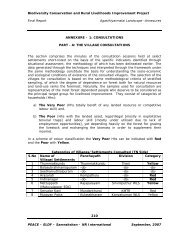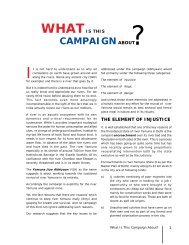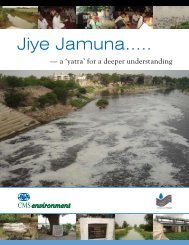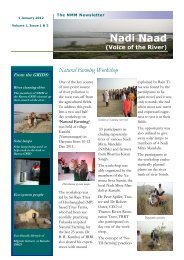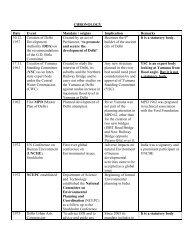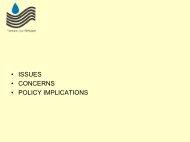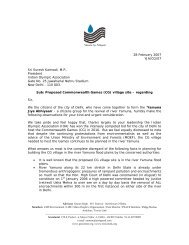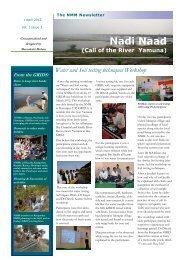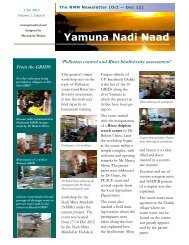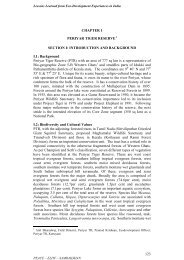1 - PEACE Institute Charitable Trust
1 - PEACE Institute Charitable Trust
1 - PEACE Institute Charitable Trust
You also want an ePaper? Increase the reach of your titles
YUMPU automatically turns print PDFs into web optimized ePapers that Google loves.
CITES UPDATE<br />
case of live specimens there will always be<br />
a risk of an escape. Information should be<br />
kept at hand, such as a list of experts in<br />
animal and plant handling, identification<br />
and care; a list of rescue centres; and the<br />
telephone numbers where the<br />
Management Authority can be reached<br />
(keeping in mind that confiscations often<br />
occur in the evening and at weekends).<br />
Basic equipment can include a bird net,<br />
leather gloves, snake hooks, facemasks,<br />
protective eyewear, surgical gloves, cloth<br />
sacks, a large clean container (such as a<br />
rubbish container with a lid), towels and<br />
blankets, and antibacterial soap.<br />
Handling wildlife can be dangerous, and it<br />
is important to take precautions for your<br />
safety, that of your colleagues, and for the<br />
safety of the specimens. Animals are often<br />
faster and much stronger than might be<br />
expected. Quite apart from the damage<br />
that can be caused by claws, teeth, beaks,<br />
toxins, spines or others, animals can also<br />
carry infectious diseases such as hepatitis<br />
A and B, psittacosis and salmonella. Dead<br />
specimens may also pose a risk, for<br />
instance, hunting trophies may have sharp<br />
claws, talons, horns or antlers, and they<br />
may have been treated with chemicals,<br />
which are poisonous if inhaled. Handling<br />
plants can also be risky, as plants may<br />
secrete toxic substances or have sharp<br />
spines, and they may have been treated<br />
with chemicals and pesticides.<br />
The Secretariat<br />
CITES Resource<br />
(We provide here reference to useful resource<br />
material on CITES – Editor)<br />
2005 Checklist of CITES species now<br />
available (Source: CITES World, Issue 16<br />
December 2005)<br />
The Checklist of CITES species provides<br />
the official alphabetical list of CITES<br />
species, their scientific synonyms, their<br />
common names in English, French and<br />
Spanish (to the extent that these were<br />
available to the compilers) and an<br />
indication of the Appendix in which they<br />
are listed. The publication includes a<br />
CDROM that contains in PDF format all of<br />
the information above as well as the<br />
Annotated CITES Appendices and<br />
reservations. The latter provides the<br />
original listing date of all taxa (orders,<br />
families, genera, species, and subspecies)<br />
and populations specifically named in the<br />
current or past Appendices.<br />
It also indicates all reservations ever<br />
made by Parties, with the dates on which<br />
they entered into force and, in the case of<br />
past reservations, the dates on which they<br />
were withdrawn.<br />
This book should be particularly useful to<br />
CITES Management and Scientific<br />
Authorities, Customs officials and all<br />
others involved in implementing and<br />
enforcing the Convention.<br />
Paper copies can be ordered from the<br />
CITES Secretariat (USD 60 per copy). An<br />
electronic version can be downloaded in<br />
PDF format from the website<br />
(www.cites.org) at no cost.<br />
Field Guide for identification of Fake<br />
Skins of Tiger (Source: Regional Deputy<br />
Director (Wildlife Preservation) Southern<br />
Region, Chennai)<br />
Fakes and counterfeits are the most<br />
dreaded things in the commercial world.<br />
They eat into the legitimate market share<br />
of the genuine businessmen, and divest<br />
the consumers of their hard earned<br />
money. The law expects the enforcement<br />
authorities to protect the interests of the<br />
businessmen and the consumers by taking<br />
action against the unscrupulous persons<br />
introducing fakes and counterfeits in the<br />
Issue No. 1 of Vol. II 6




